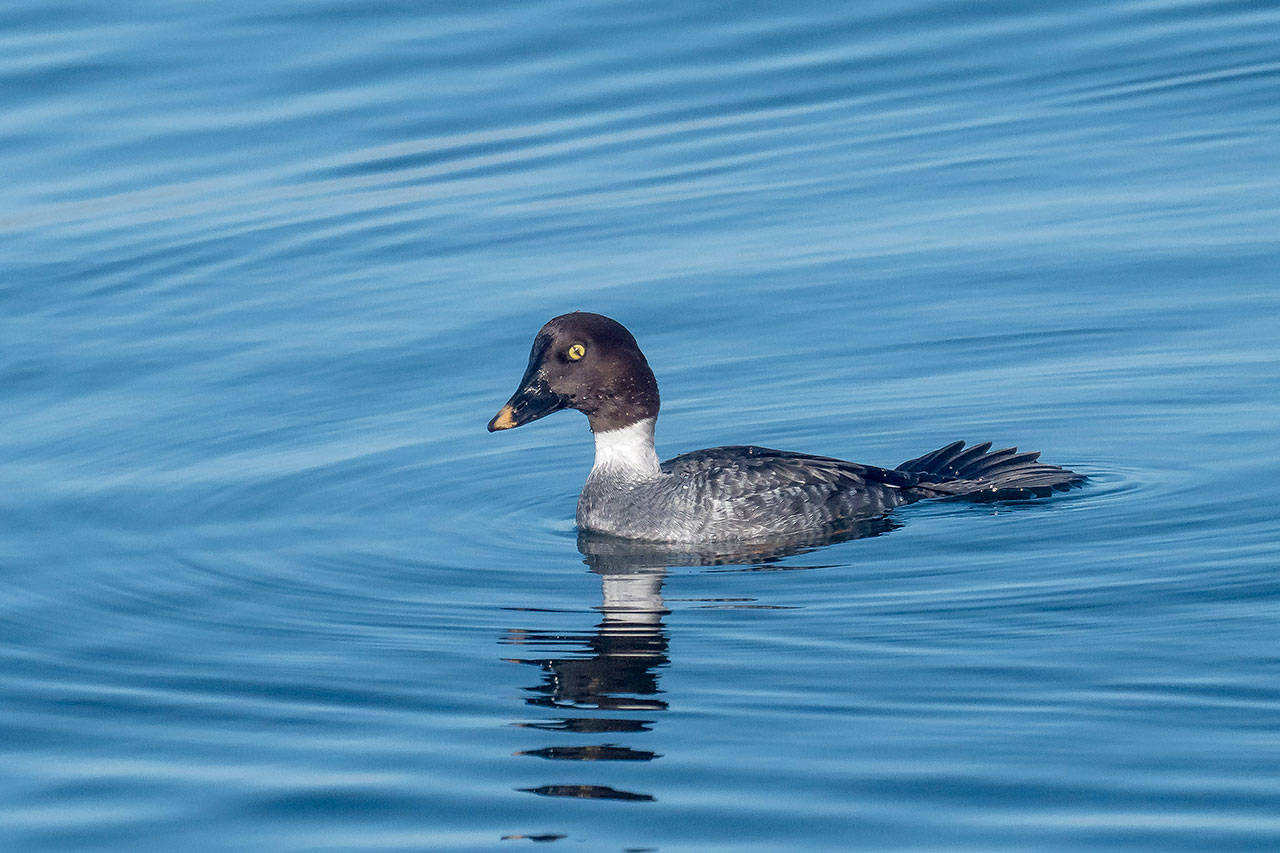By Dianna Moore
Grays Harbor Audubon Society
I have trouble identifying ducks and gulls….there I said it! I just haven’t spent the time getting to know them, despite them being fairly easy to find and observe. So I chose this duck to see if I can generate the drive to learn in myself as well as you, the reader. It helps to have Gregg Thompson’s wonderful photos to help with the I.D. He is doing a study of birds that dive and this is a duck setting up to do that very thing; note the spread tail.
General Description: Common Goldeneyes are diving ducks, so instead of the tipping upside down with tails and feet above the surface, they sort of propel themselves up and forward, submerging their whole body under water and leaving a distinct hole in the water. If I were to submit a series of Gregg’s photos they would show the entire process of the dive….including the hole in the water displaced by the body of the diving duck. This is a female goldeneye, with a gray body, brown head, yellow eyes indicating an adult, a white “neck band” and a black bill with a yellow tip. Males have a dark iridescent-green head with white cheek patches and mostly white body with a black back and white barring on the wings. Both sexes are 16 to 20 inches in length, with a wing span of about 30 to 33 inches, and weighing approximately 21 to 46 ounces.
Habitat: During the winter, goldeneyes can often be found on some of our larger rivers and in protected marine areas like shallow bays and estuaries, large lakes and ponds, with sandy, rocky or gravel bottoms. Their preference is for areas free of emergent and submerged vegetation and fish. They can also be found on sewage lagoons. Non-breeding birds often summer in the same areas as they overwinter. Breeding ducks nest in cavities in forested habitats in mature trees, either evergreen or deciduous.
Behavior: Goldeneyes forage mostly underwater, often a large group dives at the same time. This is an aggressive and territorial duck and the male performs spectacular and complex courtship displays during breeding season. The female often lays her eggs in the nests of other ducks, especially other cavity-nesting ducks.
Diet: On wintering grounds goldeneyes eat mollusks, crustaceans and fish, while on their breeding territories they eat mostly aquatic insects.
Nesting: Female Common Goldeneyes usually don’t begin breeding until they reach the age of two. They typically return to the area where they hatched (philopatry) and once they breed often return to the same nest year after year. Goldeneyes nest in northern boreal forests worldwide. Nests are located in cavities in large trees; they can be natural cavities, old woodpecker holes, and even man-made nestboxes. They use a depression in wood chips, leaves, or previous nesting material, and lined with down.
They lay seven to 10 eggs and incubate them for 28 to 32 days. After one or two weeks of incubation the male leaves for his molt migration. It is not known if the pair bonds re-form in the fall but it is thought they do. The young jump from the nest one to two days after hatching to join the female and maybe flocks of other ducklings.
Nests of goldeneyes can also be community nests, with other females laying their eggs in the nest. The female leads the young ducks to places where food is available and they are able to feed themselves. Females abandon the young before they can fly, at about five to six weeks of age. They fledge at eight to nine weeks of age.
Migration: After incubation begins males leave for a short molt-migration to an area possibly a bit north of their normal territory, where they molt and stage for their winter migration. Often they don’t arrive on their wintering grounds until late October, early November. Males migrate farther north than females, as far north as they can find open water. Their spring migration begins in late February. They breed in the upper boreal forests.
Conservation Status: The population of Common Goldeneyes appears to be stable and has even increased thanks to nestboxes being accepted. Some of the ongoing concerns are for areas farther north that have recent industrial effluent that keeps water ice-free. The concentrations of ducks in these areas leads to the worry about the spread of diseases, and also the pollution of these industrial ponds. They also seem to prefer acidified waters which provide a good prey base but may contain toxins.
Where and When to Find on Grays Harbor: The best times to see Common Goldeneyes is November through April, either on fresh-water lakes, ponds, and rivers, or on calm salt water…of which we have aplenty!


